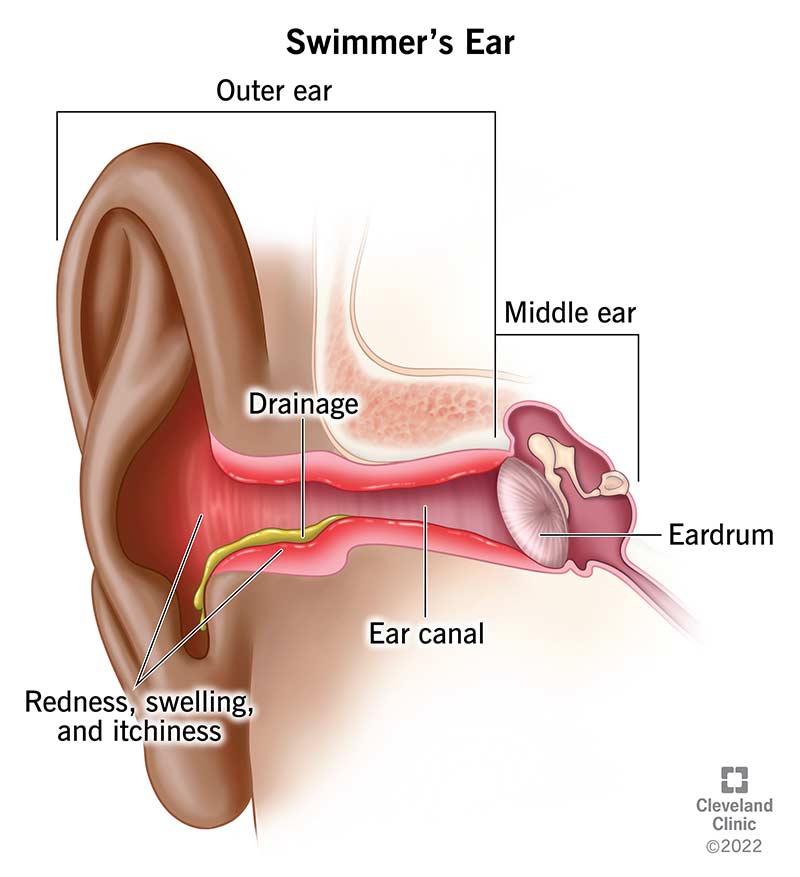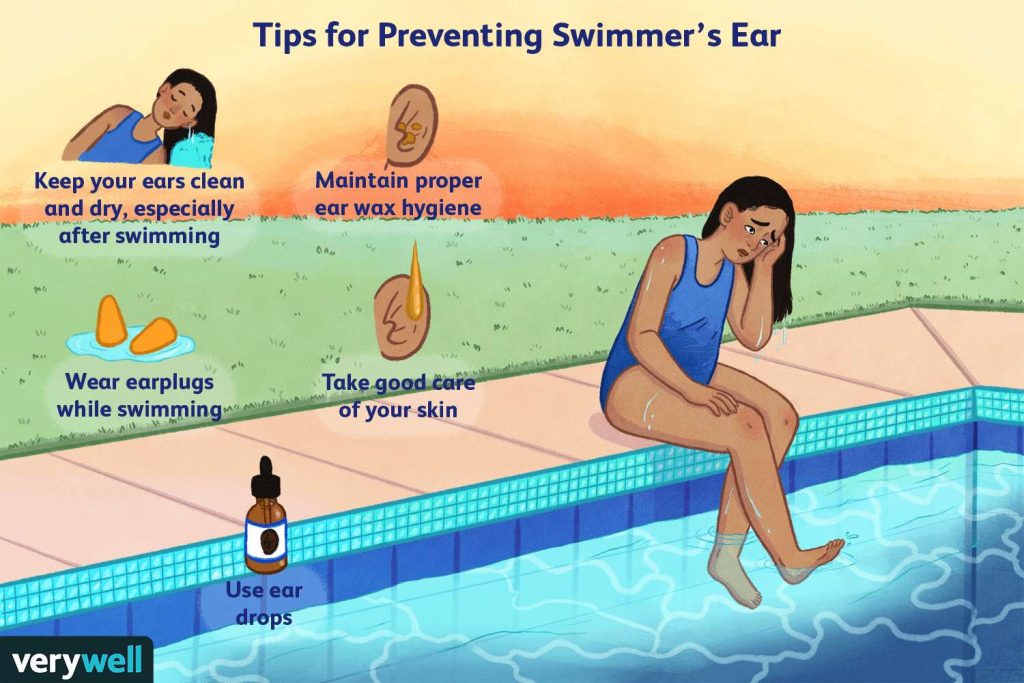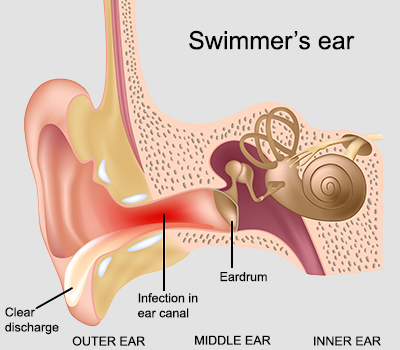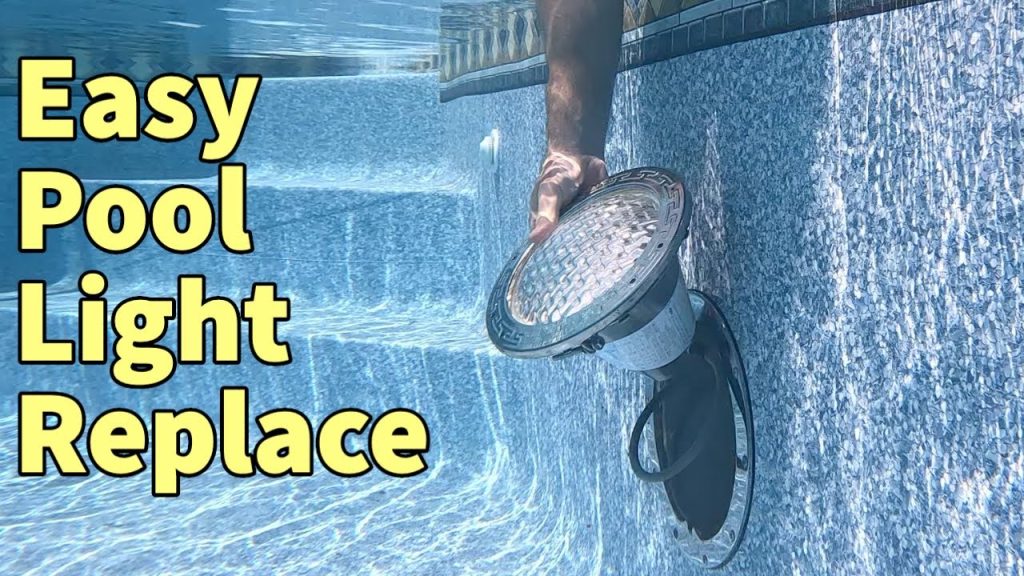To avoid complications, you should wait before swimming after an ear infection. This helps ensure proper healing and reduces the risk of reinfection.
Ear infections are common and can be painful. They affect both children and adults. Swimming too soon can lead to more problems. Water can introduce bacteria into the ear, worsening the infection. Knowing how long to avoid swimming is important.
It helps in the recovery process and maintains ear health. In this blog, we will discuss the recommended waiting period. We will also share tips to protect your ears while swimming. This information will help you enjoy swimming safely after an ear infection.

Credit: my.clevelandclinic.org
Introduction To Ear Infections
Ear infections are common, especially in children. They can cause discomfort and pain. Understanding ear infections helps in managing and preventing them.
Common Causes
Ear infections usually result from bacteria or viruses. They often follow a cold or respiratory infection. Other factors can also contribute:
- Allergies
- Sinus infections
- Excess mucus
- Smoking or exposure to cigarette smoke
- Changes in air pressure
Symptoms And Signs
Recognizing the symptoms of an ear infection is important for early treatment. Here are common signs to watch for:
| Symptom | Description |
|---|---|
| Ear Pain | Sharp or dull pain in the ear. |
| Hearing Loss | Muffled sounds or difficulty hearing. |
| Fluid Drainage | Clear or pus-like fluid from the ear. |
| Fever | Temperature above 100°F (37.8°C). |
| Irritability | Especially common in infants. |
If you notice these symptoms, consult a doctor. Early treatment can prevent complications.

Credit: www.healthdirect.gov.au
Impact Of Swimming On Ear Infections
Swimming can be refreshing and fun. But, it can also harm those recovering from an ear infection. The impact of swimming on ear infections is significant. Water exposure can delay healing. It can even worsen the infection.
Why Swimming Can Be Harmful
Swimming introduces bacteria into the ear. These bacteria thrive in moist environments. The ear canal may stay wet for long periods after swimming. This moisture allows bacteria to grow, leading to infections.
Chlorinated pools are not safe either. Chlorine can irritate the sensitive skin in the ear canal. This irritation can cause inflammation. It can make the ear more prone to infections.
Risks Associated With Swimming
Swimming with an ear infection can lead to several risks. Some common risks include:
- Increased Pain: Water in the ear can cause more pain.
- Prolonged Healing: Moisture can slow the healing process.
- Spread of Infection: Bacteria in water can spread the infection.
Doctors recommend avoiding swimming for at least two weeks after an ear infection. This allows the ear to heal properly. Always consult your doctor for personalized advice.
Expert Guidelines On Swimming Post-infection
Ear infections can be painful and bothersome. Recovering from one takes time and care. Following expert guidelines ensures a safe return to activities like swimming. Avoiding water in the ear helps prevent the infection from worsening or returning.
General Waiting Period
Most experts suggest waiting 7 to 14 days before swimming. This period allows the infection to heal completely. Healing reduces the risk of reinfection. Always follow your doctor’s advice.
Factors Influencing Recovery Time
Several factors affect how long you should avoid swimming. The severity of the infection plays a key role. A mild infection may heal faster than a severe one.
Your overall health also impacts recovery time. Strong immune systems fight infections better. If you have a weak immune system, healing may take longer.
Proper treatment speeds up recovery. Antibiotics and ear drops help clear the infection. Follow the prescribed treatment plan for best results.
Water quality is important too. Swimming in clean water reduces the risk of new infections. Avoid swimming in dirty or contaminated water.
Always consult your doctor before resuming swimming. They can provide personalized advice based on your condition.
Ear Infection Types And Swimming Restrictions
Swimming can be risky after an ear infection. Different types of ear infections require different swimming restrictions. Understanding these can help in making the right decisions for your health.
Outer Ear Infections
Outer ear infections, also known as swimmer’s ear, affect the ear canal. This type of infection is common among swimmers. Water trapped in the ear can cause bacteria to grow. To avoid complications, avoid swimming until the infection clears.
Doctors usually recommend waiting at least one week. Use earplugs if you need to swim. Keep the ear dry and clean to prevent further infection.
Middle Ear Infections
Middle ear infections occur behind the eardrum. They are more common in children. These infections are less related to swimming but can still cause issues. Pressure changes in water can worsen the pain.
Doctors suggest avoiding swimming for at least two weeks. This gives the ear time to heal. Follow the doctor’s advice for the best recovery. This helps prevent complications and ensures a smooth healing process.
Precautions To Take While Swimming
Swimming after an ear infection requires extra care. Water exposure can lead to more problems. So, it’s essential to take some precautions.
Using Ear Plugs
Ear plugs are a great tool to prevent water from entering your ears. They are especially useful after an ear infection.
- Choose high-quality silicone ear plugs. They provide a tight seal.
- Ensure ear plugs fit well. This avoids any leakage.
- Replace ear plugs regularly. It ensures hygiene and effectiveness.
Using ear plugs can help you swim safely. It reduces the risk of further infection.
Avoiding Certain Waters
Not all water bodies are safe after an ear infection. Some waters may contain bacteria or chemicals. These can aggravate your ear condition.
| Water Type | Reason to Avoid |
|---|---|
| Rivers and Lakes | They often have high bacteria levels. |
| Public Pools | Chlorine can irritate the ear canal. |
| Beaches | Saltwater may cause discomfort. |
It’s safer to swim in clean, controlled environments. This can help prevent any complications.
Signs You’re Ready To Swim Again
After experiencing an ear infection, it is crucial to ensure your ear has fully healed before returning to the water. Swimming too soon can lead to complications or a recurrence of the infection. Here are some signs that you may be ready to swim again.
No Pain Or Discomfort
One of the primary indicators that your ear has healed is the absence of pain or discomfort. You should not feel any pain when touching your ear. There should be no pressure or aching sensation in the ear. If you experience any discomfort, it is best to wait longer.
Clearance From A Doctor
Always seek clearance from a healthcare professional before resuming swimming. A doctor can examine your ear to ensure it has healed properly. They may check for any remaining infection or fluid in the ear. This professional advice is essential for your safety.
Alternative Activities During Recovery
Recovering from an ear infection can be challenging, especially if you are used to swimming. Staying out of the water is crucial, but there are many alternative activities you can enjoy during this time. Keeping yourself active and entertained will help you maintain a positive outlook.
Low-impact Exercises
Low-impact exercises are great for maintaining fitness without straining your ears.
- Walking: Take a brisk walk in the park or around your neighborhood.
- Yoga: Engage in gentle yoga poses that promote relaxation and flexibility.
- Stretching: Perform simple stretching routines to keep your muscles limber.
- Cycling: Use a stationary bike for a low-impact cardio workout.
Indoor Activities
Indoor activities can keep you entertained and mentally stimulated.
| Activity | Description |
|---|---|
| Reading | Immerse yourself in a good book or magazine. |
| Puzzles | Engage your mind with jigsaw puzzles or Sudoku. |
| Board Games | Play board games with family or friends. |
| Art and Crafts | Explore your creative side with painting or knitting. |
By focusing on these alternative activities, you can ensure a smooth recovery. Staying active and engaged helps you stay positive and speeds up the healing process. Remember to consult your doctor before starting any new activity during your recovery.
Preventing Future Ear Infections
After recovering from an ear infection, it’s important to take steps to prevent future infections. Simple measures can make a significant difference in keeping your ears healthy. Below, we discuss effective strategies for maintaining proper ear hygiene and protective measures to avoid ear infections.
Proper Ear Hygiene
Maintaining proper ear hygiene is crucial. Clean your ears gently with a damp cloth. Avoid inserting objects like cotton swabs into the ear canal. Use ear drops if recommended by your doctor. These actions help keep the ears clean and free from potential irritants.
Teach children good ear hygiene habits. Encourage them to dry their ears thoroughly after swimming or bathing. This can prevent moisture build-up which often leads to infections.
Protective Measures
Taking protective measures can reduce the risk of ear infections. Here are some effective tips:
- Use earplugs when swimming to keep water out.
- Wear a shower cap to protect your ears during showers.
- Avoid exposing your ears to loud noises.
- Stay away from smoke-filled environments.
If you have allergies, manage them properly. Allergies can cause ear infections due to inflammation and fluid build-up.
Consider getting vaccinated. Vaccines can prevent certain types of ear infections, especially in children.
By following these tips, you can significantly reduce the risk of future ear infections.
Consulting Healthcare Professionals
Experiencing an ear infection can be quite uncomfortable. It’s important to know when to consult a healthcare professional. Consulting with a doctor ensures you get the right treatment. It also helps you understand when it’s safe to swim again.
When To Seek Medical Advice
Seek medical advice if your ear infection symptoms worsen. Look for signs like severe pain, fever, or fluid discharge. Persistent symptoms lasting more than a few days also need medical attention. It’s crucial to prevent complications and ensure proper healing.
Questions To Ask Your Doctor
Prepare questions before your doctor visit. Ask how long you should avoid swimming. Inquire about any specific precautions to take. Clarify if ear drops or other treatments are needed. Understanding your recovery process helps you follow guidelines better.
:max_bytes(150000):strip_icc()/VWH_Illustration_Ear-Infections_Ellen-Lindner_Final-5c93d104719f4886b5aa2999b17a9c69.jpg)
Credit: www.verywellhealth.com
Frequently Asked Questions
How Long Should You Wait To Swim After An Ear Infection?
You should wait at least 7 to 10 days before swimming. This ensures your ear has healed properly and reduces the risk of re-infection.
Can Swimming Worsen An Ear Infection?
Yes, swimming can worsen an ear infection. Water exposure can introduce bacteria and delay the healing process of your ear.
What Precautions Should You Take Before Swimming?
Use earplugs and avoid diving to prevent water from entering your ears. Consult your doctor for personalized advice.
How Do You Know If Your Ear Infection Is Healed?
You should be free from pain, discharge, and hearing loss. Always consult your doctor to confirm full recovery.
Conclusion
Avoid swimming for at least a week after an ear infection. This helps the ear heal properly. Water can worsen the infection or cause new issues. Always follow your doctor’s advice for the best care. Keeping your ears dry speeds up recovery.
Enjoy swimming once you’re fully healed. Protecting your health ensures more fun in the water later.



